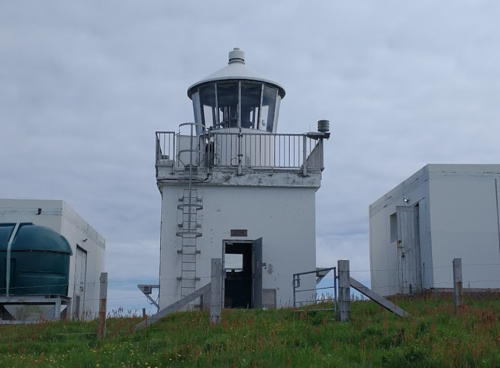The United Kingdom (officially the United Kingdom of Great Britain and Northern Ireland) includes England, Scotland, Wales, and Northern Ireland. Occupying the northern third of the island of Great Britain, the kingdom of Scotland has shared its monarch with England since 1603 and has been part of the United Kingdom since 1707. The coastline of the country is deeply cut by inlets, and there are more than 790 islands. The country has a long and distingushed maritime history; many of the most famous British captains and navigators have been Scots.
This page covers lighthouses of the Western Isles of Scotland, often called the Outer Hebrides (Na h-Eileanan Siar in Scottish Gaelic). The islands extend in a chain from north northeast to south southwest, separated from the Highlands mainland and from the Isle of Skye in the Inner Hebrides by a sound called The Minch and from the southern Inner Hebrides by a bay called the Sea of the Hebrides. The largest islands are Lewis and Harris (actually a single island), North Uist, and South Uist.
Scotland was divided historically into 34 counties; the counties no longer have any administrative function although they continue to have cultural significance. Since 1996 the country has been divided into 32 council areas for the purposes of local government. Until 1975 the Isle of Lewis was in the county of Ross and Cromarty and the rest of the islands were in Inverness-shire. In 1975 the islands were united in a unitary council area called Comhairle nan Eilean Siar ("Council of the Western Isles"). The council area is also a lieutenancy area, meaning that it has a Lord Lieutenant representing the monarch. Its population is about 27,000.
The islands are accessible by air or by Caledonian MacBrayne ferries from various locations in western Scotland. The four light stations reasonably accessible without a boat are all on or close to the Isle of Lewis, which is accessible by ferry from Ullapool in the northern Highlands or from Uig on the Isle of Skye.
The Northern Lighthouse Board manages all the lighthouses of the Western Isles except for the harbor lights of Stornoway, the largest town of the islands.
Scottish Gaelic is commonly spoken in the islands. The Scottish Gaelic phrase for a lighthouse is taigh solais; eilean is an island, sgeir is a skerry or rock, and rubha or àird is a cape or promontory.
ARLHS numbers are from the ARLHS World List of Lights. Admiralty numbers are from Volume A of the Admiralty List of Lights & Fog Signals. U.S. NGA numbers are from Publication 114.
- General Sources
- Northern Lighthouse Board - Lighthouse Library
- The Board's web site includes information and photos for many of the lighthouses.
- Michael's Comprehensive List of Scottish Lights
- Data and photos posted by Michael Spencer. Section S covers Lewis and Harris and Section T covers the rest of the Western Isles.
- Lighthouse Archives
- Lighthouse information from LighthouseAccommondations.uk.
- Online List of Lights - Scotland
- Photos by various photographers posted by Alexander Trabas.
- United Kingdom Lighthouses
- Aerial photos posted by Marinas.com.
- Lighthouses in the Outer Hebrides
- Photos available from Wikimedia; many of these photos were first posted on Geograph.org.uk.
- World of Lighthouses - Scotland
- Photos by various photographers available from Lightphotos.net.
- Britische Leuchttürme auf historischen Postkarten
- Historic postcard images posted by Klaus Huelse.
- The Stevensons
- The history of Scotland's remarkable family of lighthouse engineers, posted by David Taylor.
- GPSNauticalCharts
- Navigational chart for the islands.

Butt of Lewis Light, Port of Ness, March 2024
Instagram photo by andy_macp

Ushenish Light, South Uist, May 2022
Google Maps photo by Mark Downie






